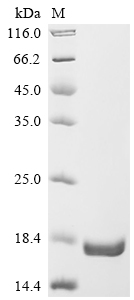Recombinant Human Anoctamin-1 (ANO1) , partial
CAT:
399-CSB-EP713621HU2-02
Size:
100 µg
Price:
Ask
- Availability: 24/48H Stock Items & 2 to 6 Weeks non Stock Items.
- Dry Ice Shipment: No




Recombinant Human Anoctamin-1 (ANO1) , partial
- CAS Number: 9000-83-3
- Gene Name: ANO1
- UniProt: Q5XXA6
- Expression Region: 806-892aa
- Organism: Homo sapiens
- Target Sequence: SFTSDFIPRLVYLYMYSKNGTMHGFVNHTLSSFNVSDFQNGTAPNDPLDLGYEVQICRYKDYREPPWSENKYDISKDFWAVLAARLA
- Tag: N-terminal 10xHis-tagged and C-terminal Myc-tagged
- Source: E.coli
- Field of Research: Tags & Cell Markers
- Assay Type: In Stock Protein
- Relevance: Calcium-activated chloride channel (CaCC). Plays a role in transepithelial anion transport and smooth muscle contraction. Required for the normal functioning of the interstitial cells of Cajal (ICCs) which generate electrical pacemaker activity in gastrointestinal smooth muscles. Acts as a major contributor to basal and stimulated chloride conductance in airway epithelial cells and plays an important role in tracheal cartilage development. Required for CFTR activation by enhancing endoplasmic reticulum Ca (2+) store release and is also required for CFTR membrane expression. Required for basal and ATP-dependent mucus secretion in airways and intestine, probably by controlling exocytosis of mucus-filled granules by providing Ca (2+) to an apical signaling compartment. Contributes to airway mucus expression induced by interleukins IL3 and IL8 and by the asthma-associated protein CLCA1 and is required for expression of mucin MUC5AC. However, was shown in another study not to be required for MUC5AC expression. Plays a role in the propagation of Ca (2+) waves in Kolliker's organ in the cochlea and contributes to the refinement of auditory brainstem circuitries prior to hearing onset. In vomeronasal sensory neurons, modulates spontaneous firing patterns in the absence of stimuli as well as the firing pattern of pheromone-evoked activity. Responsible for calcium-activated chloride channel activity in type I taste cells of the vallate papillae. Acts as a heat sensor in nociceptive neurons. In dorsal root ganglion neurons, plays a role in mediating non-histaminergic Mas-related G-protein coupled receptor (MRGPR)-dependent itching, acting as a downstream effector of MRGPRs. In the developing brain, required for the Ca (2+)-dependent process extension of radial glial cells. ; [Isoform 4]: Calcium-activated chloride channel (CaCC). Contributes to calcium-activated chloride secretion in human sweat gland epithelial cells. Shows increased basal chloride permeability and decreased Ca (2+)-induced chloride permeability. ; [Isoform 5]: Calcium-activated chloride channel (CaCC). Shows increased sensitivity to intracellular Ca (2+).
- Purity: Greater than 90% as determined by SDS-PAGE.
- Activity: Not Test
- Length: Partial
- Form: Liquid or Lyophilized powder
- Buffer: If the delivery form is liquid, the default storage buffer is Tris/PBS-based buffer, 5%-50% glycerol. If the delivery form is lyophilized powder, the buffer before lyophilization is Tris/PBS-based buffer, 6% Trehalose, pH 8.0.
- Reconstitution: We recommend that this vial be briefly centrifuged prior to opening to bring the contents to the bottom. Please reconstitute protein in deionized sterile water to a concentration of 0.1-1.0 mg/mL.We recommend to add 5-50% of glycerol (final concentration) and aliquot for long-term storage at -20℃/-80℃. Our default final concentration of glycerol is 50%. Customers could use it as reference.
- Molecular Weight: 17.6 kDa
- References & Citations: "The novel marker, DOG1, is expressed ubiquitously in gastrointestinal stromal tumors irrespective of KIT or PDGFRA mutation status." West R.B., Corless C.L., Chen X., Rubin B.P., Subramanian S., Montgomery K., Zhu S., Ball C.A., Nielsen T.O., Patel R., Goldblum J.R., Brown P.O., Heinrich M.C., van de Rijn M. Am. J. Pathol. 165:107-113 (2004)
- Storage Conditions: The shelf life is related to many factors, storage state, buffer ingredients, storage temperature and the stability of the protein itself. Generally, the shelf life of liquid form is 6 months at -20℃/-80℃. The shelf life of lyophilized form is 12 months at -20℃/-80℃.
